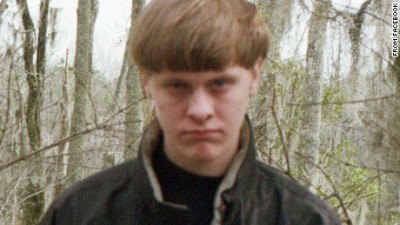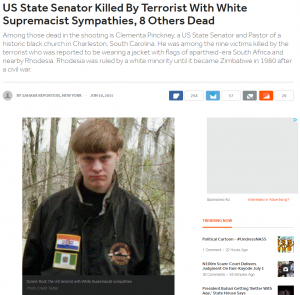How One Outlet Covered the Charleston Massacre Right

The day after 21-year-old Dylann Roof allegedly gunned down nine members of Emanuel African Methodist Episcopal Church, a historic black church in Charleston, S.C., the coverage of the coverage was already piling up, much of it lamenting the apparent pass the media was giving Roof.
Despite the fact that the attack meets the textbook definition of terrorism, critics noted that the press was, by and large, not identifying Roof as a terrorist:
- “Listen to major outlets, and you won’t hear the word ‘terrorism’ used in coverage of Wednesday’s shooting” (Anthea Butler in the Washington Post);
- “When US citizens … appear to be ‘normal,’ that is white and/or Christian, terroristic violence is rarely labeled as such, even when the political roots of the killing are clear” (Robert Jensen, quoted in the International Business Times);
- “#CharlestonShooting terrorist wore an Apartheid flag on his jacket. If a Muslim man wore an ISIS flag, he wouldn’t get past mall security” (Samuel Sinyangwe on Twitter, quoted in the New York Times);
- “Few media sources use the term [terrorism] for violent actors motivated by, for example, white supremacy or anti-government rage” (Brian Phillips interviewed by the Washington Post’s Monkey Cage blog);
- “It leaves us with the question of whether or not there is a disconnect between how black and white people view violence against black bodies” (Terrell Jermaine Starr in AlterNet);
- “Don’t call this the act of a madman. It is an insult to those battling mental illness and it is also a degree of deference you never saw given to men like Osama Bin Laden” (Shaun King republished in Daily Kos).
Items in this vein have continued to crop up over the ensuing days.
Yet there was at least one news item that ran the day after the shooting that was not afraid to refer to it as a terrorist attack: “US State Senator Killed by Terrorist With White Supremacist Sympathies, 8 Others Dead,”reads the headline of a news item that appeared on Sahara Reporters, a New York City-based news website that primarily covers government corruption in Africa, with a particular focus on Nigeria.
The Sahara Reporters piece uses the word “terrorist” six times to describe Roof and his alleged action, including in the headline, the subhead and a photo caption. The words “mental illness,” “troubled” and “loner” do not appear — in fact, no speculation whatsoever is made regarding Roof’s mental state or stability. Instead, South Carolina’s “known hate groups” are mentioned to provide context for Roof’s alleged actions, and Roof’s white supremacist activities and the historic allusions made by the patches on his jacket are front and center in the piece. And the massacre is clearly contextualized as occurring at “a time where the persecution of black ethnic minorities in the United States has been making world headlines.”
The piece’s distinctiveness from typical US reports on the attack doesn’t end there. The story’s lead prominently identifies Clementa Pinckney, the church’s pastor and one of the shooting victims, as a South Carolina state senator. While it seems clear at this point that Roof targeted Emanuel AME in part because of its history as a center of black resistance to white supremacy, it is not apparent that Roof was targeting Pinckney personally or because of his office. But one might expect the highly unusual fact of an elected official being killed in a terrorist attack to feature prominently in coverage–as it likely would have, had a white politician been killed by a person of color.
The straighforwardness of the reporting in the Sahara Reporters piece makes it easy to identify what many observers have asserted is missing from the US media’s coverage. Perhaps it’s not surprising to see an outlet that frequently covers Nigeria–which, after all, has some experience with ethnically motivated violence–get it right. Sahara Reporters earned wide notice in 2009 for publishing the first photo of Umar Farouk Abdulmutallab, the so-called “underwear bomber” of Northwest Flight 253, and again in 2011 for breaking news, reactions and photos of the car-bombing of a United Nations outpost in Abuja, Nigeria.
Journalists covering stories like Charleston, Ferguson and Baltimore–and other racial flashpoints that will undoubtedly continue to explode–would do well to take notes.
Shane Smith (Twitter: @JShaneSmith) is a freelance writer based in Jersey City, N.J.


